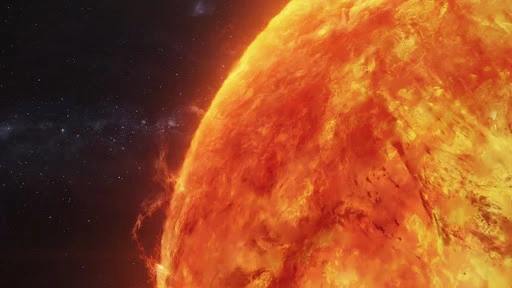Our Sun, despite appearing warm and calm from Earth, is a giant ball of fiery gas that constantly churns and releases incredible bursts of energy. Sometimes, these bursts manifest as spectacular solar flares or massive expulsions of plasma known as coronal mass ejections, which can impact Earth’s technology, ranging from satellites to power grids. But even on a smaller scale, the Sun is incredibly dynamic, with constant activity that helps us understand the fundamental processes driving these larger, more impactful events. One such fascinating phenomenon is the chromospheric fan-shaped jet, often described as light walls or peacock jets due to their appearance. These jets are like miniature, recurrent fireworks erupting from the Sun’s lower atmosphere, the chromosphere. Understanding them gives us a clearer picture of the Sun’s secrets.
Recently, a team of researchers from the Indian Institute of Astrophysics, Bengaluru, University of Oslo, Norway, NASA Marshall Space Flight Center, USA, University of Alabama in Huntsville, USA, and the Big Bear Solar Observatory, USA, studied the mechanics behind these intriguing fan-shaped jets. They wanted to understand what makes these jets appear repeatedly, sometimes lasting for over an hour, and how they are powered.
Did you know?Just like Earth has a troposphere and stratosphere, the Sun has different layers. The chromosphere, where these fan-shaped jets occur, is a reddish layer above the visible surface (photosphere) and below the super-hot corona. |
Previous studies had often focused on similar jets originating from light bridges, which are bright structures found within the dark centres of sunspots. However, this new research focused on jets that appear in the intergranular lanes – the spaces between the granular patterns on the Sun’s surface, specifically between sunspots that have the same magnetic polarity. This distinction is important because it shows that similar energetic processes can occur in different magnetic environments on the Sun.
To unravel this mystery, the researchers used a combination of telescopes. They gathered high-resolution images from the Goode Solar Telescope (GST) at the Big Bear Solar Observatory, which provided incredibly detailed views of the jets in a specific wavelength of light. They combined this with data from instruments aboard NASA’s Solar Dynamics Observatory (SDO): the Atmospheric Imaging Assembly (AIA), which captures images of the Sun in various ultraviolet wavelengths, and the Helioseismic and Magnetic Imager (HMI), which maps the Sun’s magnetic fields. By looking at the jets in different wavelengths of light and observing the magnetic field changes, they could piece together the complete picture.
They discovered a dramatic interplay of magnetic forces. The HMI magnetic field maps revealed a crucial event happening at the base of these jets: magnetic flux cancellation. This is essentially when magnetic field lines of opposite polarities meet and effectively cancel each other out. The researchers observed a gradual decrease in these opposite-polarity magnetic fields right where the jets were forming. As this cancellation occurred, the jets became more intense, and they eventually stopped when the minority magnetic field disappeared entirely. This strongly suggests that magnetic reconnection, a process where tangled magnetic field lines break and reconnect, releasing immense energy, is the primary driver.
Further analysis, using computer models to extrapolate the magnetic field into three dimensions, showed a complex magnetic structure at the jet’s base. They found what’s called a 3D magnetic null point at a height of about 1.25 million meters (or 1250 kilometres) above the Sun’s surface. This is a hypothetical point where the magnetic field strength drops to zero, and around it, the magnetic field lines form a specific fan-spine shape. This kind of topology is known to be very favorable for magnetic reconnection.
The researchers propose that these observations align perfectly with a model called the minifilament eruption model, which was previously used to explain larger jets in the Sun’s corona (the outermost atmosphere). In this model, a small, twisted bundle of magnetic field lines, like a tiny magnetic rope, becomes unstable and erupts. This eruption triggers two types of magnetic reconnection: internal reconnection at the base, which creates a bright point, and external reconnection higher up, which then forms the fan-shaped jet, propelling plasma outwards. This study provides strong evidence that this minifilament eruption mechanism, driven by magnetic flux cancellation, is responsible for these recurrent chromospheric fan-shaped jets.
The work demonstrates that the minifilament eruption model, previously applied to coronal jets, also explains these smaller, recurrent chromospheric jets. Crucially, it highlights that the magnetic conditions necessary for these jets, driven by flux cancellation, can exist not only in sunspot light bridges but also in the intergranular lanes between sunspots. While the study provides compelling evidence, the researchers acknowledge that such observations are rare, which limits the number of events that can be studied in detail.
Understanding these recurrent fan-shaped jets, even if they seem small compared to massive solar flares, is vital for society. The Sun’s activity, from the smallest jets to the largest eruptions, is all interconnected. By studying these fundamental processes, scientists can build more accurate models of the Sun’s magnetic behaviour. This, in turn, helps us better predict space weather events that can disrupt our modern technological world. Every piece of the solar puzzle, including these beautiful fan-shaped jets, brings us closer to a future where we can better prepare for and mitigate the effects of the Sun’s powerful temperament.
This article was written with the help of generative AI and edited by an editor at Research Matters.
